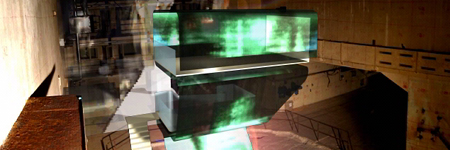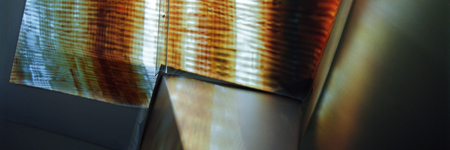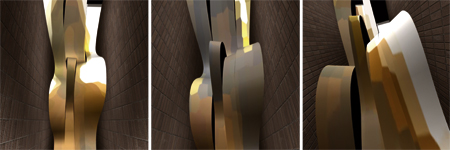 SAPS, the Streaming Architecture Projective Space spatial media concepts merges physical space with media environments. The SAPS concepts is founded in the relationship between projected moving image and transformed physical space, supported by real-time Internet broadcast technology.
SAPS, the Streaming Architecture Projective Space spatial media concepts merges physical space with media environments. The SAPS concepts is founded in the relationship between projected moving image and transformed physical space, supported by real-time Internet broadcast technology.
The physical and mediated aspects of SAPS dissolve the boundaries of its physical surroundings. The classical display case is inverted through the generated content displaced in multiple locations. The visual identity is continuously re-created through daily updates, in a process of responsive management over time.SAPS creates a space in constant motion, through real-time generated imagery distributed via Internet, satellite, and finally anamorphic projected. Real-time media can be merged with pre-recorded audio-visual material. The spatial concept can operated in different types of environments, ranging from new ways of exhibiting in museum context, public places to exhibition spaces and commercial venues.
 Streaming Architecture Projective Space concept is developed thorugh series of prototypes in different media and scales. Parallel studies have explored real-time media technologies, transformation algorithms and the performance of SAPS in different spatial configurations.The prototypes have been both on a conceptual level, such as animated collages produced from digital 3D-models, as well as full-scale fully operational enviroments. Media content has consisted of real-time streaming media over Internet connection or via direct camera capture, Video Jockey real-time audio-visual editing as well as pre-recorded material.The prototypes have been developed in sequence, from SAPS.00 animated collages, through SAPS.01 scale physical models, SAPS.02 full-scale prototype, SAPS.03 proposal for a rebuilt cinema and the SAPS.04 proposed interventions in semi-public spaces.
Streaming Architecture Projective Space concept is developed thorugh series of prototypes in different media and scales. Parallel studies have explored real-time media technologies, transformation algorithms and the performance of SAPS in different spatial configurations.The prototypes have been both on a conceptual level, such as animated collages produced from digital 3D-models, as well as full-scale fully operational enviroments. Media content has consisted of real-time streaming media over Internet connection or via direct camera capture, Video Jockey real-time audio-visual editing as well as pre-recorded material.The prototypes have been developed in sequence, from SAPS.00 animated collages, through SAPS.01 scale physical models, SAPS.02 full-scale prototype, SAPS.03 proposal for a rebuilt cinema and the SAPS.04 proposed interventions in semi-public spaces.
Media, space and technology
The SAPS media content from different sources is simultaneously merged in the physical installation, but can also be clearly separated by the fragmented set-up of the physical interventions. Distortions of projected media are performed in real time, to allow adjustment due to different angles of projection surfaces. These distortions work through anamorphs, perspective distortions, and add another level of complexity to the classical principle, in that they can continuously shift.
 SAPS uses broadband Internet and mpeg2/mpeg4 streaming. Television quality will be achieved in the images using public networks for communication and distribution. The technology allows integration of interactive use of mobile telephones. A spectator could take part in the creation of live images and set up a conversational contact with the installation. The international transmission is using a new multicast protocol, which enables the above proposal (and the work with the nonTVTVstation). Splintermind and TeliaSonera are developing this protocol.
SAPS uses broadband Internet and mpeg2/mpeg4 streaming. Television quality will be achieved in the images using public networks for communication and distribution. The technology allows integration of interactive use of mobile telephones. A spectator could take part in the creation of live images and set up a conversational contact with the installation. The international transmission is using a new multicast protocol, which enables the above proposal (and the work with the nonTVTVstation). Splintermind and TeliaSonera are developing this protocol.
The configuration of the physical space is distributed, and opens up the space to the outside, and simultaneously establishes different focus areas. Different spatial interventions both carry the projected media and create a differentiated terrain. Characteristics such as open/closed, light, sound or sightlines are gradually shifting throughout the area. The different spatial conditions together with the manipulable media content allow adaptation to changing activities during the day. Branding element can shift into artwork or curated mediated events such as presentations, VJ-sessions, fashion shows or ambient lounge mingles.
 Commission
Commission
The SAPS spatial concept can be integrated into an existing environment, be part of a design in development or be established as a separate project. The development is typically initiated though a preliminary study, which defines requirements and suggests a potential design approach, often in collaboration with curators or branding consultants. During the project development phase the SAPS project team uses specially developed tools as a support for the design process, enabling complete control over the development of projection beams, spatial configuration and real-time media distortions.
SAPS.00 included studies through digital animated collages, testing different spaces and functions augmented by media production. The prototypes proposed new spaces for media galleries and commercial spaces, exploring the borders between art and commerce.
SAPS.00
concept development and animated collages:
Jonas Runberger, ssark medialab
concept development:
Ari Leinonen, ssark
concept development and media content:
Mikael Scherdin, Beeoff
concept development and management:
Björn Norberg, Beeoff
SAPS.01, featured a scale prototype with two integrated projectors and a real-time visual mixer. The prototype allowed for hands-on exploration of a series of scale models, while physical parts were subject to projected real-time media. During a workshop event, outside parties were invited to participate in these investigations.The prototype was used as a screen set for a series of show reels, including material for a potential automobile marketing event and initial studies for the SAPS.02 full-scale prototype.
SAPS.01
concept development and physical design:
Jonas Runberger, ssark medialab
concept development and media mixer:
Mikael Scherdin, Beeoff
The SAPS.02 full-scale prototype was designed for the specific gallery space of Art.platform, Stockholm. The spatial set-up featured three separate wall partitions, each with a linked projector. Real-time filters automatically adjusted projected media to be displayed correctly on the curving surfaces of the walls. The SAPS.02 prototype was tested as a show room, conference space, mock-up fashion store and as a video jockey venue with real-time audio-visual performances.
SAPS.02
concept development and physical design:
Jonas Runberger, ssark medialab
concept development and media content:
Mikael Scherdin, Beeoff
Streaming and transformation technologies:
Tomas Linell, Beeoff
The SAPS.02 prototype was developed in collaboration with and with support from research project Cross-disciplinary studies of Complexity and transformation.
The prototype was presented in the Art.platform gallery space in November 2004.
Special thanks to: Cheryl Akner Koler Carolina de la Fe Vidar Hertov Anton Ljungberg Senem Yazan
SAPS.03 is a proposal for a passage way between different levels of the classical Fountain cinema of Vällingby, Sweden. Joining the 1950’s entrance hall with new additions currently under construction, it takes advantage of the vistors’ horizontal and vertical movement as they progress inte the lower levels. The physical part of the installation distorts media when viewed from below, but gives a clear view from the top of the staricase. The media content can be operated through subscription, and adjusted continuously for different ambiences over the day, including material from current shows as well as material from the history of this classical cinema.
SAPS.03
concept development and physical design:
Jonas Runberger, ssark medialab
concept development:
Mikael Scherdin, Beeoff
media content:
Tomas Linell, Beeoff
SAPS.04 returns to the animated collage in a series of proposed additions to wxisting semi-public environemnts. The studies cover lounge situations, meeting rooms, bars and restaurants. Further refining techniques developed in SAPS.01, the animated collage provides valuable support in initial design development, using a combination of photograph, moving image, digital 3D model, image processing and media post-production.
SAPS.04
concept development, spatial design and post-production:
Jonas Runberger, ssark medialab
concept development:
Mikael Scherdin, Beeoff
Leave a Reply